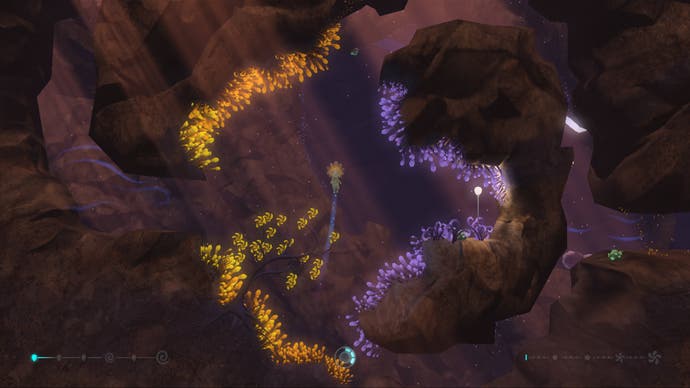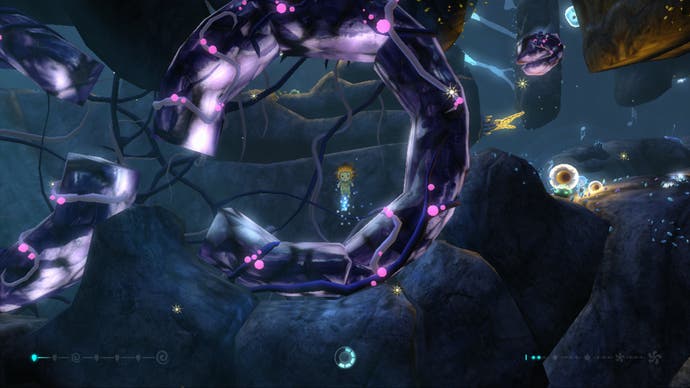The UnderGarden
Gardeners whirled.
The first thing you should know: The UnderGarden is a game. That may seem like stating the obvious, but it's true. Every mention of the game so far has made prominent use of the word "casual", usually followed by any combination of "ambient", "trippy" and "chilled out". The impression given is that it's more of an interactive mushroom experience and not the sort of game to totally harsh your buzz with downers like objectives and completion ratings and woah man, just relax, OK?
And to begin with, that seems like a fairly accurate description. You control a chubby alien pixie thing, able to float through the air in a garden that makes Avatar's lush luminous jungle look like a manky old lettuce and a couple of dandelions. It's a sumptuous, wondrous environment and one that immediately rewards exploration.
Bounce off a green blob, helpfully brought to your attention by the minimalist tutorial, and a cloud of pollen ejaculates lazily into the air. As you scoop it up, each piece gives off a tinkling chime, an escalating sing-song scale that makes the game's key mechanic a tactile joy.

Once carrying your fill of pollen, the garden bursts into life whenever you pass by dormant flora. Tendrils burst excitedly from the walls and floor, carpets of glowing grass pop and sway with evident joy. Each comes with its own sound, transforming your movements into musical flourishes that feed into the relaxing soundtrack.
It is, frankly, beautiful and the simple pleasure of making stuff happen ensures that the first few minutes of play go a long way to winning you over. It's a game to sink into, like a big soft duvet and the prospect of blissful sleep after a night out when you're still just mashed enough to feel snuggly and content.
Gameplay introduces itself very quickly, but never intrudes into this enjoyable cocoon. There are trees in the game which bear fruit once the plants surrounding them have been pollinated. Different fruit have different effects, and can be carried by extending a small circle of influence around you. Anything that can be picked up in its radius attaches to you with a little glowing string.
To begin with, it's simple stuff. Heavy fruits can be used to weigh down pressure pads, while lumpy helium-filled fruits act as balloons and can be used to lift switches in the opposite direction. After a few basic physics puzzles in which you navigate tunnels and trapdoors using these rudimentary tools, The UnderGarden begins to show off its full range of produce.

Lantern fruits light your way through deadly dark passages. Energy fruits carry an electrical charge and can be used to power up organic technology. Exploding fruits do exactly what you'd expect, detonating with very un-chilled-out force when dropped, demolishing walls and sending gameplay objects hurtling through the air.
The game also starts to hinder your progress in a firm but gentle sort of way. Gusts of wind prevent you from travelling in certain directions, or carry you along like an autumn leaf. Cogwheels must be turned to open passages and lock doors in place. Glowing pods cause you to drop everything you're carrying, including pollen, should you bump into them.
From these simple yet interlocking abilities and obstacles, the game begins to reveal the structure beneath its mellow shell. The aim is simple – get to the end of each level, pollinating as much of the world as you can. The execution, while never truly difficult, is challenging enough to make a mockery of the idea that this is a blissed out paddling pool for the off-yer-tits crowd.
Reaching the end of each of the game's 14 stages isn't going to trouble you for long, but finding all the hidden crystals and special flowers while pollinating every plant is no mean feat. Cleverly, such completist goals are not essential. If you want to enjoy the trip, you can.

